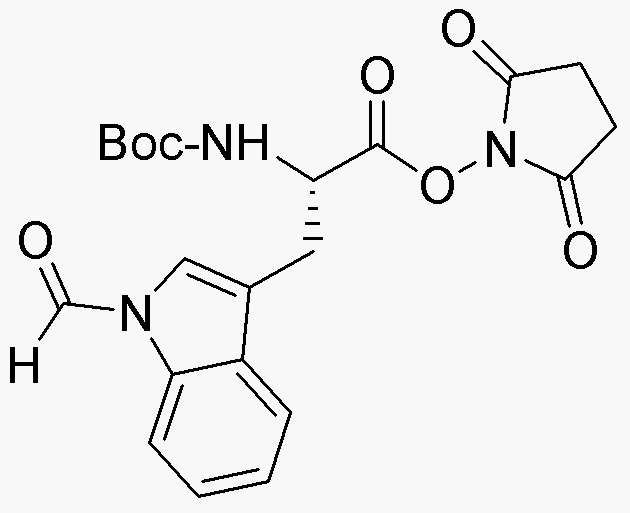Na-Boc-Nin-formyl-L-tryptophan N-hydroxysuccinimide ester is widely utilized in research focused on:
- Peptide Synthesis: This compound serves as a valuable building block in the synthesis of peptides, particularly those involving tryptophan residues, enhancing the efficiency of creating complex peptide structures.
- Drug Development: It plays a crucial role in the development of novel pharmaceuticals, especially in targeting specific biological pathways, making it a key player in medicinal chemistry.
- Bioconjugation: The compound is used in bioconjugation processes, allowing researchers to attach biomolecules to surfaces or other molecules, which is essential in creating targeted drug delivery systems.
- Fluorescent Labeling: It can be utilized for fluorescent labeling of biomolecules, facilitating the study of protein interactions and dynamics in biological systems.
- Research in Neuroscience: Given its connection to tryptophan, it is valuable in neuroscience research, particularly in studying serotonin pathways and their implications in mood disorders.
General Information
Properties
Safety and Regulations
Applications
Na-Boc-Nin-formyl-L-tryptophan N-hydroxysuccinimide ester is widely utilized in research focused on:
- Peptide Synthesis: This compound serves as a valuable building block in the synthesis of peptides, particularly those involving tryptophan residues, enhancing the efficiency of creating complex peptide structures.
- Drug Development: It plays a crucial role in the development of novel pharmaceuticals, especially in targeting specific biological pathways, making it a key player in medicinal chemistry.
- Bioconjugation: The compound is used in bioconjugation processes, allowing researchers to attach biomolecules to surfaces or other molecules, which is essential in creating targeted drug delivery systems.
- Fluorescent Labeling: It can be utilized for fluorescent labeling of biomolecules, facilitating the study of protein interactions and dynamics in biological systems.
- Research in Neuroscience: Given its connection to tryptophan, it is valuable in neuroscience research, particularly in studying serotonin pathways and their implications in mood disorders.
Documents
Safety Data Sheets (SDS)
The SDS provides comprehensive safety information on handling, storage, and disposal of the product.
Product Specification (PS)
The PS provides a comprehensive breakdown of the product’s properties, including chemical composition, physical state, purity, and storage requirements. It also details acceptable quality ranges and the product's intended applications.
Certificates of Analysis (COA)
Search for Certificates of Analysis (COA) by entering the products Lot Number. Lot and Batch Numbers can be found on a product’s label following the words ‘Lot’ or ‘Batch’.
Numéro de catalogue
Numéro de lot/série
Certificates Of Origin (COO)
This COO confirms the country where the product was manufactured, and also details the materials and components used in it and whether it is derived from natural, synthetic, or other specific sources. This certificate may be required for customs, trade, and regulatory compliance.
Numéro de catalogue
Numéro de lot/série
Safety Data Sheets (SDS)
The SDS provides comprehensive safety information on handling, storage, and disposal of the product.
DownloadProduct Specification (PS)
The PS provides a comprehensive breakdown of the product’s properties, including chemical composition, physical state, purity, and storage requirements. It also details acceptable quality ranges and the product's intended applications.
DownloadCertificates of Analysis (COA)
Search for Certificates of Analysis (COA) by entering the products Lot Number. Lot and Batch Numbers can be found on a product’s label following the words ‘Lot’ or ‘Batch’.
Numéro de catalogue
Numéro de lot/série
Certificates Of Origin (COO)
This COO confirms the country where the product was manufactured, and also details the materials and components used in it and whether it is derived from natural, synthetic, or other specific sources. This certificate may be required for customs, trade, and regulatory compliance.


